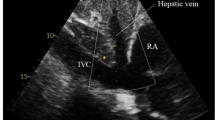Abstract
BACKGROUND: The central venous pressure (CVP) is commonly estimated at the bedside by measuring the height of the jugular venous pressure (JVP) relative to the sternal angle. Determining the CVP from this measure requires that the distance from the sternal angle to the level of the mid-right atrium be known. Classical clinical teaching quotes this distance as 5 cm, invariable between patients, and invariable with changes in the elevation of the patient’s head. The validity of these JVP characteristics has been questioned.
OBJECTIVES: To measure the distance from the sternal angle to the level of the mid-right atrium (SA-RA) and determine if the SA-RA distance varies with patient position.
METHODS: Cross-sectional study conducted at a single-center teaching hospital on ambulatory patients undergoing computed tomography of the chest.
RESULTS: One hundred sixty patients were included. The median SA-RA distance with the patient lying supine was 5.4 cm (interquartile range, 4.7 to 6.1). Using geometric calculations to estimate the SA-RA distance when the patient’s torso was elevated above the supine position, the median SA-RA distance was calculated to be 8 cm, 9.7 cm, and 9.8 cm at 30, 45, and 60 degrees elevation respectively. The SA-RA distance varied extensively between patients and was independently associated with smoking, age, and anteroposterior chest diameter.
CONCLUSIONS: The distance from the sternal angle to the level of the mid-right atrium varies considerably between individuals and with patient position. When using the JVP to calculate the CVP, physicians need to consider specific patient factors and the patient’s position.
Similar content being viewed by others
References
Economides E, Stevenson LW. The jugular veins: knowing enough to look. Am Heart J. 1998;136:6–9.
McGee SR. Physical examination of venous pressure: a critical review. Am Heart J. 1998;136:10–8.
Haywood GA, Joy MD, Camm AJ. Influence of posture and reference point on central venous pressure measurement. Br Med J. 1991;303:626–7.
Mittal SR. Jugular venous pressure-a re-appraisal. Int J Cardiol. 1985;8:109–12.
Chopra JS, Wadhwa NK, Singh G, Prakash C. Effect of posture, respiration and other factors on jugular venous pressure. J Assoc Physicians India. 1981;29:629–33.
Hedge BM. Jugular venous pulse. J Assoc Physicians India. 1987;36:515–7.
Ewy GA. Bedside evaluation of the jugular venous pulse in the acute care setting. Acute Care. 1983;10:194–9.
Butman SM, Ewy GA, Standen JR, Kern KB, Hahn E. Bedside cardiovascular examination in patients with severe chronic heart failure: importance of rest or inducible jugular venous distension. J Am Coll Cardiol. 1993;22:968–74.
Davison R, Cannon R. Estimation of central venous pressure by examination of jugular veins. Am Heart J. 1974;87:279–82.
Bloch KE, Krieger BP, Sackner MA. Noninvasive measurement of central venous pressure by neck inductive plethysmography. Chest. 1991;100:371–5.
Cook DJ, Simel DL. The Rational Clinical Examination. Does this patient have abnormal central venous pressure? JAMA. 1996;275:630–4.
Kee LL, Simonson JS, Stotts NA, Skov P, Schiller NB. Echocardiographic determination of valid zero reference levels in supine and lateral positions. Am J Crit Care. 1993;2:72–80.
Potger KC, Elliott D. Reproducibility of central venous pressures in supine and lateral positions: a pilot evaluation of the phlebostatic axis in critically ill patients. Heart Lung. 1994;23:285–99.
Borst JG, Molhuysen JA. Exact determination of the central venous pressure by a simple clinical method. Lancet. 1952;2:304–9.
Braunwald E. The Physical Examination. Philadelphia: W.B. Saunders; 1988:13–40.
Sapira JD. Veins. The Art and Science of Bedside Diagnosis. Baltimore: Urban and Schwarzenberg; 1990:355–69.
Bates B. The Cardiovascular System. A Guide to Physical Examination and History Taking. Philadelphia: J.B. Lippincott; 1987:253–310.
Dell’Italia LJ, Starling MR, O’Rourke RA. Physical examination for exclusion of hemodynamically important right ventricular infarction. Ann Intern Med. 1983;99:608–11.
Amoroso P, Greenwood RN. Posture and central venous pressure measurement in circulatory volume depletion. Lancet. 1989;2:258–60.
Kurihara Y, Yoshiko KY, Matsumoto J. The ribs: anatomic and radiologic considerations. Radiographics. 1999;19:105–19.
Bommer W, Weinert L, Neumann A, Neef J, Mason DT, DeMaria A. Determination of right atrial and right ventricular size by two-dimensional echocardiography. Circulation. 1979;60:91–100.
Kleinbaum DG, Kupper LL, Muller KE, Nizam A. Confounding and interaction in regression. Applied regression analysis and multivariable methods. Pacific Grove, Calif: Duxbury Press; 1998:186–211.
Drake JJ. Locating the external reference point for central venous pressure determination. Nurs Res. 1974;23:475–82.
McGee S, Abernethy WB, Simel DL. Is this patient hypovolemic. JAMA. 1999;281:1022–9.
Guyton AC, Greganti FP. A physiologic reference point for measuring circulatory pressures in the dog—particularly venous pressure. Am J Physiol. 1956;185:137–41.
Cook DJ. The clinical assessment of central venous pressure in the critically ill. Am J Med Sci. 1990;299:175–8.
Author information
Authors and Affiliations
Corresponding author
Additional information
Dr. van Walraven is supported by an Ontario Ministry of Health Career Scientist Award.
The views expressed herein are solely those of the authors and do not represent the views of any of the sponsoring organizations.
Rights and permissions
About this article
Cite this article
Seth, R., Magner, P., Matzinger, F. et al. How far is the sternal angle from the mid-right atrium?. J GEN INTERN MED 17, 861–865 (2002). https://doi.org/10.1046/j.1525-1497.2002.20101.x
Issue Date:
DOI: https://doi.org/10.1046/j.1525-1497.2002.20101.x




